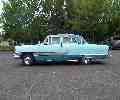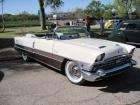|
Re: 1940 356 engine problem
|
||||
|---|---|---|---|---|
|
Home away from home

|
Dear Bill:
If the compression was even before the work then trace seepage is not uncommon especially in the presense of preignition due to carbon. If you were scraping carbon some may have gotten stuck under a valve. The lower compression readings indicate carbon build up. I would pull the valve cover and check the action. If the valves aren't stuck, then get them in closed position and turn back and forth with pliers. This may dislodge the offending debris.
Posted on: 2013/1/30 22:45
|
|||
|
||||
|
Re: 1940 356 engine problem
|
||||
|---|---|---|---|---|
|
Forum Ambassador
|
One thing I'd be wondering is if the head had been milled before and if the new gasket was as thick as the old. With either of those conditions met or changed could the additional milling have allowed the valves to finally touch the head. I had that issue on a 54 head and had to grind a slight relief above the valves so they would clear.
Posted on: 2013/1/30 23:55
|
|||
|
Howard
|
||||
|
||||
|
Re: 1940 356 engine problem
|
||||
|---|---|---|---|---|
|
Home away from home

|
That situation occured to me as well, but in that case the head should be replaced. I'm trying to be optimistic.
Posted on: 2013/1/31 9:36
|
|||
|
||||
|
Re: 1940 356 engine problem
|
||||
|---|---|---|---|---|
|
Forum Ambassador

|
Other than finding an NOS head, finding a cylinder head with a known history as to any past milling is not likely to happen and the only practical way to determine if it has been milled before is to "cc" the combustion chambers. This is why it's important to do a "dry fit" of the head after milling to insure there is enough valve clearance. In a few cases of desperation I've successully used a Dremel to grind a bit of valve clearance into the head. Done with care it's a better answer than using double headgaskets which rarely works for more than a couple of hundred miles at best.
In this case the poster says it was milled only 0.012" which is fine, except you don't know that it wasn't previously milled, perhaps more than once. What happens with insufficient clearance is that one or more valve heads will hit the head which can (will) bend the valve head which prevents the valve from sealing. That's why, after milling ahead, it's always important to check the clearance. There are a couple of ways to do this and we've discussed them in the past quite a few times. I'm not saying this is Bill's problem, but it's a possibility to evaluate.
Posted on: 2013/1/31 9:48
|
|||
|
||||
|
Re: 1940 356 engine problem
|
||||
|---|---|---|---|---|
|
Home away from home
|
Here's a 356 cylinder head on eBay... a high-compression head to boot.
ebay.com/itm/170972806491?ssPageName=STRK:MEWAX:IT&_trksid=p3984.m1423.l2649
Posted on: 2013/1/31 10:14
|
|||
|
West Peterson
1930 Packard Speedster Eight boattail (SOLD) 1940 Packard 1808 w/Factory Air (SOLD) 1947 Chrysler Town and Country sedan 1970 Camaro RS 1936 Cord phaeton packardinfo.com/xoops/html/modules/newbb/viewtopic.php?topic_id=4307&forum=10 aaca.org/ |
||||
|
||||
|
Re: 1940 356 engine problem
|
||||
|---|---|---|---|---|
|
Home away from home
|
Thanks everyone for the feed back. Yes, I believe the head was milled before as there was a .060 stamped on the head surface. Thought I had correctly used a micrometer and determined there was plenty of clearance between the valve and the head. There was carbon on the top of the combustion chamber which I wire brushed off. I did not see any valve marks in the carbon. The new head gasket seemed to be at least as thick as the original. The new gasket was copper and iron faced with a what appeared to be an asbestos filler. But yes, I should have also dry fitted the head as well.The next step is to see what's going on with the valves lifters, springs and keepers. Having a hard time getting clearance to get the inside fender cover off so in can inspect the valve trane. Has has anyone done this on a 40 with the 356 engine?
Posted on: 2013/1/31 15:02
|
|||
|
||||
|
Re: 1940 356 engine problem
|
||||
|---|---|---|---|---|
|
Forum Ambassador

|
If the head had already been milled 0.060" I'd guess that it was already teetering right on the edge of being unuseable; perhaps another 0.012" clinched it though assuming all this is the reason for the problem, I'm surprised that only 1 valve has apparently bent - I would have expected more than 1 cylinder with little or no compression. Of course there is less tolerance for milling a high compression head as they have less "meat" to begin with, generally the standard compression heads are far better choices if milling a head might be in your future.
I've never sat with a micrometer and measured head gaskets but I'd bet that with the exception of the thicker "export" gasket they are all pretty much the same thickness. I check valve clearance either one of two ways. First, with the block, head and old used gasket surfaces clean, I just reassemble the head on the block with a used (and thus previously compressed) gasket and let it just lay of it's own weight - no head nuts attached. Then just rotate the engine either by the starter or by hand and keep a very close watch on the head for any movement or rocking which would be caused by the valve heads hitting the top of the compression chamber. If no movement you're probably OK though you don't know just how close to the edge you might be. The second and more elaborate method is the same as above except that I first put some modelling clay or very soft glazier's putty on the head of the valve, install the head and used gasket as above, and again rotate the engine until all the valves have raised and lowered at least once. Then remove the head and check the clay or putty to see how much clearance was present.
Posted on: 2013/1/31 16:11
|
|||
|
||||
|
Re: 1940 356 engine problem
|
||||
|---|---|---|---|---|
|
Home away from home

|
Dear Bill:
I think there is plenty of clearance in the 356 which is why I didn't start talking about valve smash issues. Over milling those heads will cause combustion problems and detonation. As for the splash aprons, I have experience with those and they are a royal pain especially with sidemount fenders. In 1941 they changed to two pieces because the dealers were going ape. Get the car up high and put the jack stand under the frame so that the wheel is hanging. Remove the carburetor and gas lines. Remove the heat shield. The thing may then come out the top after some manipulation or come up high enough to swing over the shock absorber, but the last one I did came out the top.
Posted on: 2013/1/31 17:17
|
|||
|
||||
|
Re: 1940 356 engine problem
|
||||
|---|---|---|---|---|
|
Home away from home

|
When my '51 288 came back from the shop after a valve job when I first got it, there was a "valve noise". Since my hearing is marginal at best, I got a stethoscope. When I applied that to the idling engine I could hear a faint "ringing" sound. The shop had milled the head for the valve job though I had intended to tell them not to unless it was absolutely necessary. I remember a thread about the ringing sound from couple of years ago but have forgotten what that means. Anybody?
Posted on: 2013/1/31 17:22
|
|||
|
1951 200 Deluxe Touring Sedan
1951 200 Deluxe Touring Sedan (parts ?) 1951 Patrician Touring Sedan 1955 Patrician Touring Sedan |
||||
|
||||








